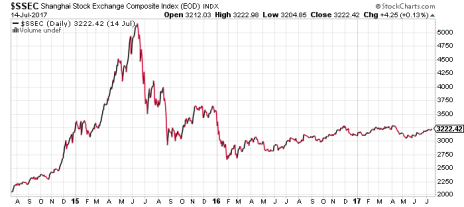The Chinese stock market has been in steady recovery for the past 18 months after a rough second half of 2015. Since its January 2016 bottom, the Shanghai Composite is up roughly 16%. Yesterday, China’s benchmark stock index received more good news.
The Chinese economy expanded 6.9% in the June quarter, a tick ahead of expectations (+6.8%) and ahead of the country’s stated 6.5% GDP growth goal for 2017. Though China’s growth is about half what it was during the early-1990s and pre-recession high points, its economy has at least stabilized after years of slowing growth. China has now expanded its GDP between 6.7% and 7.2% in each of the last 12 quarters.
[text_ad]
A stable Chinese economy has yielded stable results from the Chinese stock market. And in light of its huge late-2015 crash (the Shanghai Stock Exchange lost nearly half its value in just seven months) following a major run-up, perhaps stability is the best thing for Chinese stocks right now. The Chinese stock market has already done “exciting,” and the penalty for anyone invested in that artificially-enhanced excitement was stiff. These days, investing in Chinese stocks feels like less of a risk (see three-year chart below).
That’s essentially what fund managers for the Morgan Stanley Capital International (MSCI) global equity indexes were saying when they added 222 Chinese stocks last month. For years, MSCI’s Emerging Markets index did not include Chinese stocks due to the interference of the Chinese government and the unpredictability of China’s currency.
Paul Goodwin, our resident emerging markets expert, wrote about MSCI’s decision recently:
“Like all good capitalist institutions, MSCI insists that market forces be allowed to control market action—not government policies. The number of trading suspensions has declined over the past year or so and more Chinese stocks are now tradable through Hong Kong exchanges where transactions are in Hong Kong dollars. Both of these developments helped bring about MSCI’s move.”
MSCI’s stamp of approval should help assuage fears from U.S. investors concerned that investing in Chinese stocks is too risky. The best way to do it is through Chinese ADRs (American Depositary Receipts). ADRs are international stocks that have been vetted and certified by major U.S. exchanges. And right now, there are plenty of good Chinese ADRs out there.
Many of them are in Paul Goodwin’s Cabot Global Stocks Explorer advisory portfolio. In fact, eight of the 10 stocks in Paul’s current portfolio hail from China. Combined, they have an average return of 64.5%!
So if you feel confident in China’s steadying economy, and want to unearth some of the best investments in the Chinese stock market, our Cabot Global Stocks Explorer advisory would be a great place to start. Click here to subscribe.
[author_ad]


